MICROSOFT OFFICIAL: New Updated 70-410 Exam Questions from Braindump2go 70-410 pdf dumps and 70-410 vce dumps! Welcome to download the newest Braindump2go 70-410 vce&pdf dumps: http://www.braindump2go.com/70-410.html (471 Q&As)
Real Latest 70-410 Exam Questions Updated By Official Microsoft Exam Center! Braindump2go Offers 70-410 Dumps sample questions for free download now! You also can visit our website, download our premium Microsoft 70-410 Exam Real Answers, 100% Exam Pass Guaranteed!
Exam Code: 70-410
Exam Name Installing and Configuring Windows Server 2012
Certification Provider: Microsoft
Corresponding Certifications: MCSA, MCSA: Windows Server 2012, MCSE, MCSE: Desktop Infrastructure, MCSE: Private Cloud, MCSE: Server Infrastructure
Keywords:70-410 Dumps,70-410 Exam Questions,70-410 VCE,70-410 VCE Free,70-410 PDF,70-410 Lab Manual PDF,70-410 Practice Exams,70-410 Practice Tests,70-410 Installing and Configuring Windows Server 2012

QUESTION 121
You have a server named Server1 that runs Windows Server 2012 R2.
Server1 has following storage spaces:
– Data
– Users
– Backups
– Primordial
You add an additional hard disk to Server1.
You need to identify which storage space contains the new hard disk.
Which storage space contains the new disk?
A. Data
B. Primordial
C. Users
D. Backups
Answer: B
Explanation:
New Disks (Unallocated space) added to Primordial spacePrimordial Pool?
All storage that meets acceptable criteria for Storage Spaces will be placed in the Primordial Pool. Thiscan be considered the default pool for devices from which any other pools will be created. Notice that there are no other virtual disks or pools at this point. The Primordial Pool will only consist ofphysical storage devices that do not belong to any other pools.
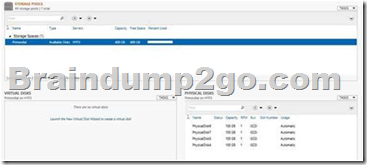
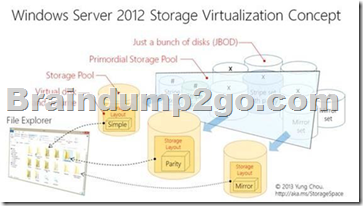
http://blogs.technet.com/b/canitpro/archive/2012/12/13/storage-pools-dive-right-in.aspx http://blogs.technet.com/b/askpfeplat/archive/2012/10/10/windows-server-2012-storagespaces-is- it-for-youcould-be.aspx
QUESTION 122
You have a server named Server1. Server1 runs Windows Server 2012 R2 and has the File and Storage Services server role installed.
You attach four 500-GB disks to Server1.
You need to configure the storage to meet the following requirements:
– Storage for an application named Application1 must be provided. Application1 requires 20 GB and will require a maximum of 800 GB in three years.
– Storage for an application named Application2 must be provided. Application2 requires 20 GB and will require a maximum of 900 GB in three years.
– The solution must provide the ability to dynamically add storage without requiring configuration changes to the applications.
– The storage must be available if a single disk fails.
Which two actions should you perform? (Each correct answer presents part of the solution. Choose two.)
A. From File and Storage Services, create virtual disks by using fixed provisioning.
B. From File and Storage Services, create a storage pool that uses all four disks.
C. From Disk Management, create two new mirror volumes that use two disks each.
D. From Disk Management, create a new RAID-5 volume that uses all four disks.
E. From File and Storage Services, create virtual disks by using thin provisioning.
Answer: BE
Explanation:
Original answer is AB.
But the correct answer is B and E. it can’t be A, because a fixed disk can’t get expanding.
QUESTION 123
Your network contains multiple subnets.
On one of the subnets, you deploy a server named Server1 that runs Windows Server 2012 R2.
You install the DNS Server server role on Server1, and then you create a standard primary zone named contoso.com.
You need to ensure that client computers can resolve single-label names to IP addresses.
What should you do first?
A. Create a reverse lookup zone.
B. Convert the contoso.com zone to an Active Directory-integrated zone.
C. Configure dynamic updates for contoso.com.
D. Create a GlobalNames zone.
Answer: D
Explanation:
D. use GlobalNames zones in Windows Server 2008 to take advantage of single-label names Providing Single-Label DNS Name Resolution:
While Domain Name System (DNS) is the predominant name-resolution technology in TCP/IP networks, Windows Internet Name Service (WINS) is deployed in many networks as an alternative name-resolution protocol.
GlobalNames Zone (GNZ) feature: The GNZ feature is designed to enable DNS resolution of these single-label, static, global names. You can deploy a GNZ in a single forest or across multiple forests.
GNZ is intended to aid the retirement of WINS. It is not a replacement for WINS. GNZ is not intended to support the single-label name resolution of records that are registered dynamically and therefore not managed by IT administrators. GNZ does make it possible for you to provide single-label name resolution of a fixed set of host computers whose names are guaranteed to be both global and unique.
http://technet.microsoft.com/en-us/library/cc731744.aspx
http://technet.microsoft.com/en-us/library/cc816610(v=ws.10).aspx
QUESTION 124
You have a server named Server1 that runs Windows Server 2012 R2. Server1 has six network adapters. Two of the network adapters are connected to a network named LAN1, two of the network adapters are connected to a network named LAN2, and two of the network adapters are connected to a network named LAN3.
You create a network adapter team named Team1 from the two adapters connected to LAN1.
You create a network adapter team named Team2 from the two adapters connected to LAN2.
A company policy states that all server IP addresses must be assigned by using a reserved address in DHCP.
You need to identify how many DHCP reservations you must create for Server1.
How many reservations should you identify?
A. 3
B. 4
C. 6
D. 8
Answer: B
Explanation:
2 Adapters = LAN1 = Team1 = 1 IP
2 Adapters = LAN2 = Team2 = 1 IP
2 Adapters = LAN3 = No Team = 2 IP
1 + 1 + 2 = 4
QUESTION 125
Your network contains an Active Directory domain named contoso.com.
All servers run Windows Server 2012 R2. The domain contains a server named Server1.
You open Review Options in the Active Directory Domain Services Configuration Wizard, and then you click View script.
You need to ensure that you can use the script to promote Server1 to a domain controller.
Which file extension should you use to save the script?
A. .pal
B. .bat
C. .xml
D. .cmd
Answer: A
QUESTION 126
Your network contains an Active Directory domain named contoso.com. The domain contains a server named Server!. Server1 runs a Server Core installation of Windows Server 2012 R2.
You install the DNS Server server role on Server1.
You need to perform the following configurations on Server1:
– Create an Active Directory-integrated zone named adatum.com.
– Send unresolved DNS client queries for other domain suffixes to the DNS server of your company’s Internet Service Provider (ISP).
Which Windows PowerShell cmdlets should you use? To answer, drag the appropriate cmdlet to the correct configuration in the answer area. Each cmdlet may be used once, more than once, or not at all. You may need to drag the split bar between panes or scroll to view content.

Answer:

Explanation:
Add-DnsServerDirectoryPartition: Creates a DNS application directory partition.
Add-DnsServerPrimaryZone: Adds a primary zone to a DNS server.
Set-DNSServer Overwrites a DNS server configuration.
SET-DNSServerForwarder Changes forwarder settings on a DNS server Set-DNSServerDSSetting Modifies DNS Active Directory settings.
Set-DNSServerSetting Modifies DNS server settings.
http://technet.microsoft.com/en-us/library/jj649942(v=wps.620).aspx http://technet.microsoft.com/en-us/library/jj649876(v=wps.620).aspx http://technet.microsoft.com/en-us/library/jj649845(v=wps.620).aspx http://technet.microsoft.com/en-us/library/jj649887(v=wps.620).aspx http://technet.microsoft.com/en-us/library/jj649874.aspx
http://technet.microsoft.com/en-us/library/jj649909.aspx
QUESTION 127
Your network contains an Active Directory domain named contoso.com. The network contains 500 client computers that run Windows 8.
All of the client computers connect to the Internet by using a web proxy.
You deploy a server named Server1 that runs Windows Server 2012 R2.
Server1 has the DNS Server server role installed.
You configure all of the client computers to use Server1 as their primary DNS server.
You need to prevent Server1 from attempting to resolve Internet host names for the client computers.
What should you do on Server1?
A. Create a primary zone named “.”.
B. Configure the Security settings of the contoso.com zone.
C. Create a zone delegation for GlobalNames.contoso.com.
D. Create a stub zone named “root”.
Answer: A
Explanation:
When you install DNS on a Windows server that does not have a connection to the Internet, the zone for the domain is created and a root zone, also known as a dot zone, is also created.
This root zone may prevent access to the Internet for DNS and for clients of the DNS. If there is a root zone, there are no other zones other than those that are listed with DNS, and you cannot configure forwarders or root hint servers.
Root domain
This is the top of the tree, representing an unnamed level; it is sometimes shown as two empty quotation marks (“”), indicating a null value. When used in a DNS domain name, it is stated by a trailing period (.) to designate that the name is located at the root or highest level of the domain hierarchy. In this instance, the DNS domain name is considered to be complete and points to an exact location in the tree of names. Names stated this way are called fully qualified domain names (FQDNs).
DNS Domain Name Hierarchy:
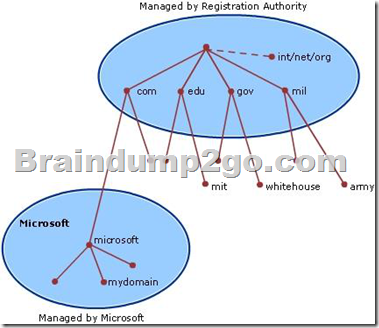
QUESTION 128
Your network contains an Active Directory domain named contoso.com.
The domain contains 100 user accounts that reside in an organizational unit (OU) named 0U1.
You need to ensure that a user named User1 can link and unlink Group Policy objects (GPOs) to OU1. The solution must minimize the number of permissions assigned to User1.
What should you do?
A. Modify the permissions on OU1.
B. Run the Set-GPPermission cmdlet.
C. Add User1 to the Group Policy Creator Owners group.
D. Modify the permissions on the User1 account.
Answer: A
Explanation:
http://www.howtogeek.com/50166/using-the-delegation-of-control-wizard-to-assign-permissions-in-server-2008/
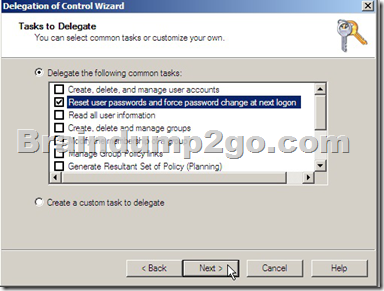
QUESTION 129
You have a server that runs Windows Server 2012 R2.
The server contains the disks configured as shown in the following table.
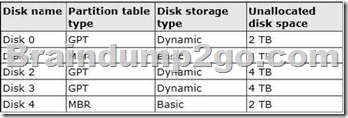
You need to create a volume that can store up to 3 TB of user files.
The solution must ensure that the user files are available if one of the disks in the volume fails.
What should you create?
A. a mirrored volume on Disk 1 and Disk 4
B. a mirrored volume on Disk 2 and Disk 3
C. a RAID-5 volume on Disk 1, Disk 2, and Disk 3
D. a spanned volume on Disk 0 and Disk 4
Answer: B
Explanation:
A mirrored volume provides an identical twin of the selected volume. All data written to the mirrored volume is written to both volumes, which results in disk capacity of only 50 percent. Any volume can be mirrored, including the system and boot volumes. The disk that you select for the shadow volume does not need to be identical to the original disk in size, or in its number of tracks and cylinders. This means that you do not have to replace a failed disk with an identical model. The unused area that you select for the shadow volume cannot be smaller than the original volume. If the area that you select for the shadow volume is larger than the original, the extra space on the shadow disk can be configured as another volume.
Dynamic disks provide features that basic disks do not, such as the ability to create volumes that span multiple disks (spanned and striped volumes) and the ability to create fault-tolerant volumes (mirrored and RAID-5 volumes).
The following operations can be performed only on dynamic disks:
Create and delete simple, spanned, striped, mirrored, and RAID-5 volumes. Extend a simple or spanned volume. Remove a mirror from a mirrored volume or break the mirrored volume into two volumes. Repair mirrored or RAID-5 volumes. Reactivate a missing or offline disk.
You need at least two dynamic disks to create a mirrored volume.
Mirrored volumes are fault tolerant and use RAID-1, which provides redundancy by creating two identical copies of a volume.
Mirrored volumes cannot be extended.
Both copies (mirrors) of the mirrored volume share the same drive letter.
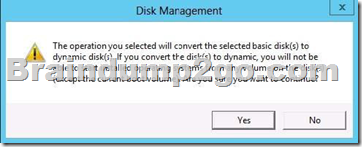
http://technet.microsoft.com/en-us/library/cc779765%28v=ws.10%29.aspx http://msdn.microsoft.com/en-us/library/windows/desktop/aa363785%28v=vs.85%29.aspx http://technet.microsoft.com/en-us/library/cc938487.aspx
QUESTION 130
What should you do for server core so it can be managed from another server 2012 R2?
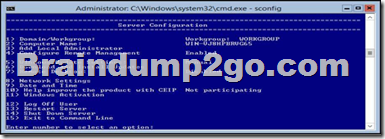
A. 1
B. 2
C. 3
D. 4
E. 5
F. 6
G. 7
H. 8
I. 9
J. 10
K. 11
L. 12
M. 13
N. 14
O. 15
Answer: H
Explanation:
4) Configure Remote Management is already “Enabled”. 8)
Network Settings
You can configure the IP address to be assigned automatically by a DHCP Server or you can assign a static IP address manually. This option allows you to configure DNS Server settings for the server as well.
http://technet.microsoft.com/en-us/library/jj647766.aspx
All the 471 Questions and Answers in Braindump2go 70-410 Exam Dumps are the latest 70-410 Real Exam Questions not just 70-410 Practice Tests Questions! Braindump2gp Microsoft 70-410 Exam Dumps PDF&VCE Guarantees you 100% Pass 70-410 Exam! Braindump2go Can Provide the Latest 70-410 Dumps Questions from Microsoft Official Exam Center for You!

70-410 PDF Dumps & 70-410 VCE Dumps Full Version Download(471q): http://www.braindump2go.com/70-410.html





